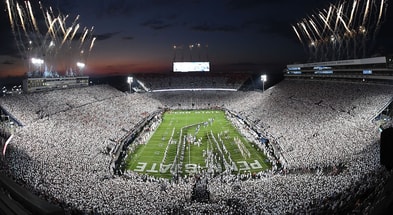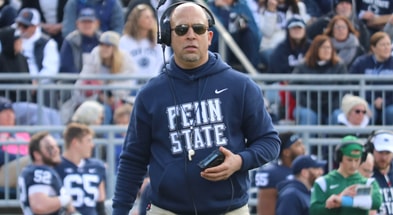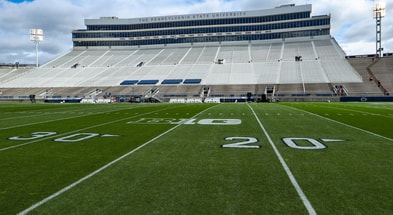Penn State to present first phase of Beaver Stadium renovation for Board of Trustees approval
Penn State president Neeli Bendapudi announced on Feb. 17 the university’s intentions for Beaver Stadium. Following years of formulating a plan for the future of the 63-year-old stadium, a major renovation was landed upon as its next step.
The project, in its final stages of planning, is soon set for the first part of formal presentation.
According to multiple sources familiar with the expansive project, the initial phase of the proposal will be presented to Penn State’s Board of Trustees at its May 4-5 meetings for a renovation with total costs estimated to run as high as $700 million.
The project will primarily focus on the west side of the stadium, including a complete demolition of the current stands and the press box. In its place, the proposal is for a rebuild with new stands, including expanded chair back seating on its lower level, as well as luxury amenities, suites, and loge boxes. Additionally, space for press seating and media amenities will be included.
Those changes will be the most dramatic and visible from within Beaver Stadium. However, sources have also confirmed that a significant portion of the project’s overall budget is intended to improve other parts of the stadium.
That work is expected to greatly improve fan movement throughout the stadium via expanded concourses and improved options for moving between stadium levels. Expanded concessions and restrooms and other major maintenance to help solidify and improve upon the ailing, aging facility are also on tap.
Some of the immediate priorities of the proposed project reflect Penn State athletic director Pat Kraft’s concerns regarding financials and how the athletic department intends to pay for the renovation under its self-sustaining model.
The goal is to create a facility that can and will be utilized beyond seven home football games a year, and to maximize those opportunities via the renovation plans. By creating new and expanded funding mechanisms through its luxury offerings, the economics of improving the stadium gradually are considered more feasible.
Limiting its scope from a complete renovation or a new build, the project is also believed internally to be more reasonable, fiscally responsible, and attainable. Its early successes at revenue generation, in turn, would then set the table for continued and expanded projects to be addressed throughout the stadium.
Other estimates through the course of the planning process landed at more than $1.2 billion for a whole stadium renovation and $1.5 billion to build new on a site adjacent to Beaver Stadium’s current location. Both options were rejected as financially unviable.
The proposal represents the first formalized steps toward converting planning into action regarding Beaver Stadium’s future. Meeting with reporters in December, Kraft acknowledged that a decision was “close.” Those comments were followed soon after with the renovation announcement in February, all leading into the first formal proposal set to take place the first week in May.
However, Kraft also noted the extent of the studies that had been conducted toward devising a plan for the stadium’s future. Saying that 19 studies had been done in the previous “eight, nine years,” he added that information had been plentiful in the process of taking actionable steps.
“I feel very comfortable… we will have a recommendation to Neeli and the board as to what direction we need to move in,” Kraft said in December. “I do think it’s coming. Now, what the board decides and how they want to move, because it is a huge project, the renovation (remains to be seen).
“We’re very close. All the data is there. Now figuring out the financial models, how would it work, what’s the recommendation, and so we’re close.”
Following the proposal to the Board of Trustees, the initial phase of the project will need to be approved and then put out for bid. The timeline on the project’s start or estimated completion is not yet known, but is expected to be contingent on board approval and the bid process.























